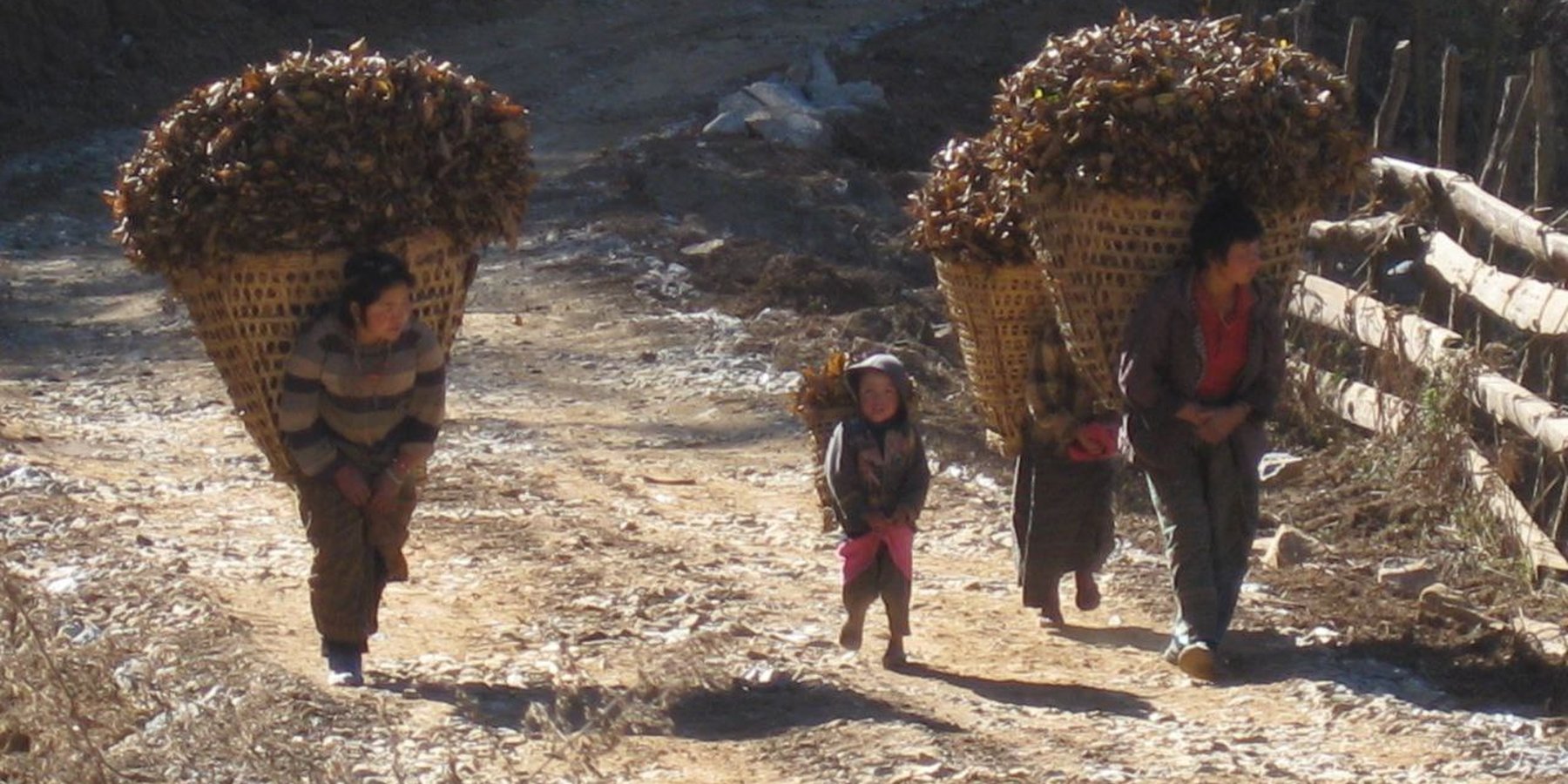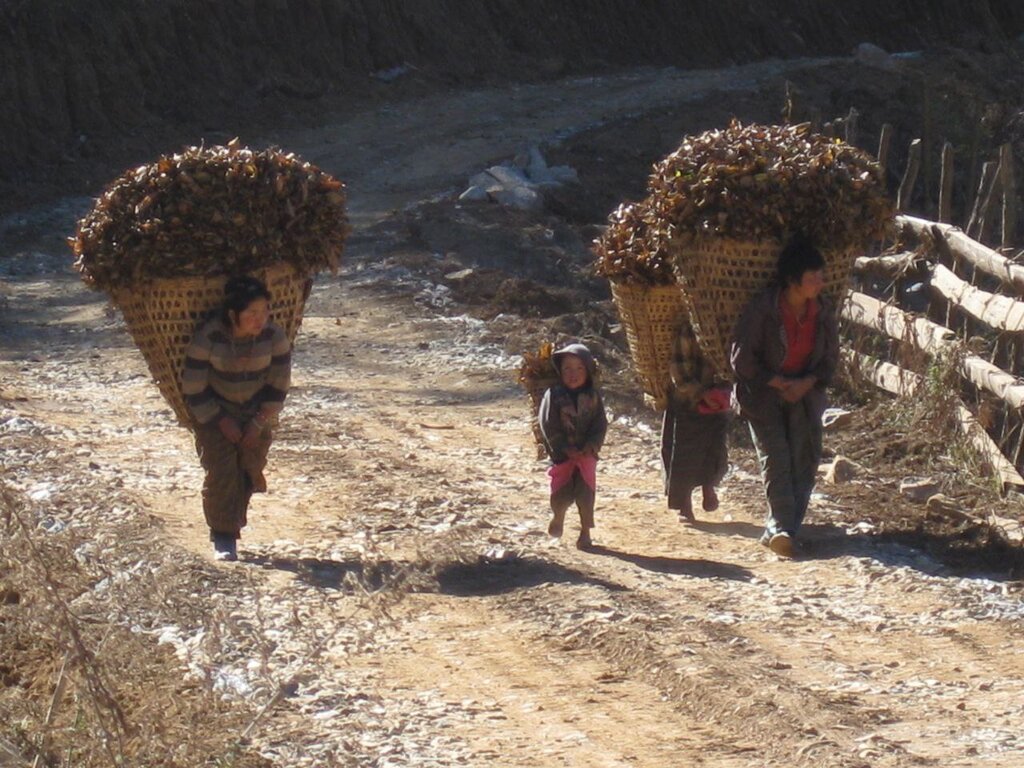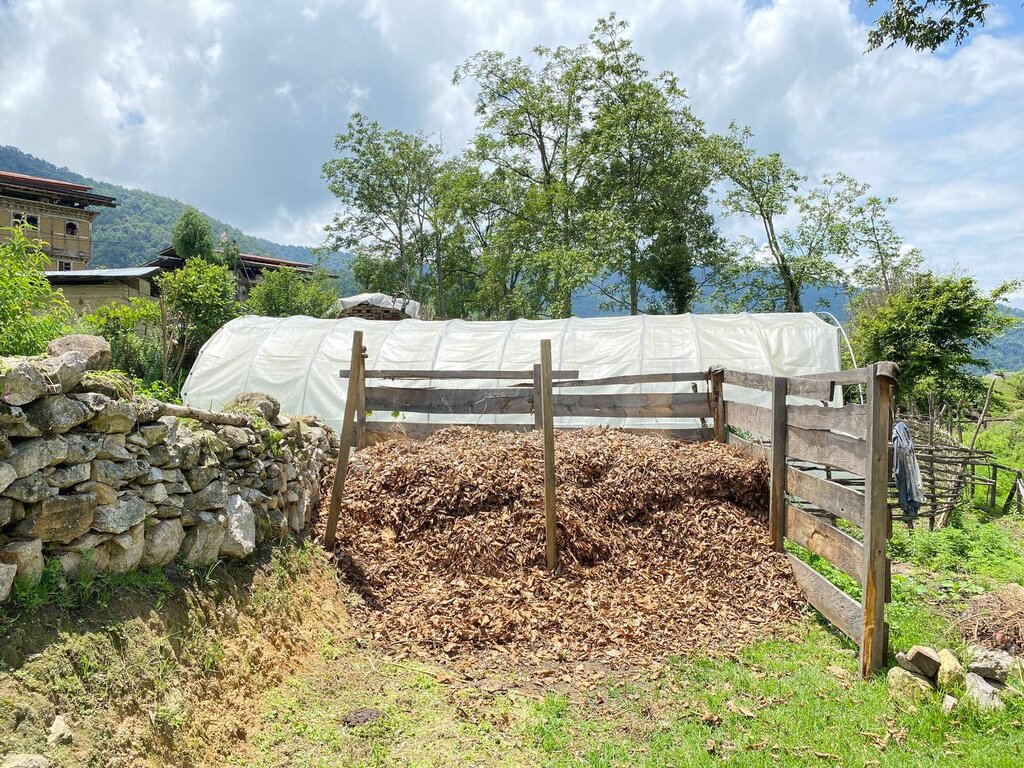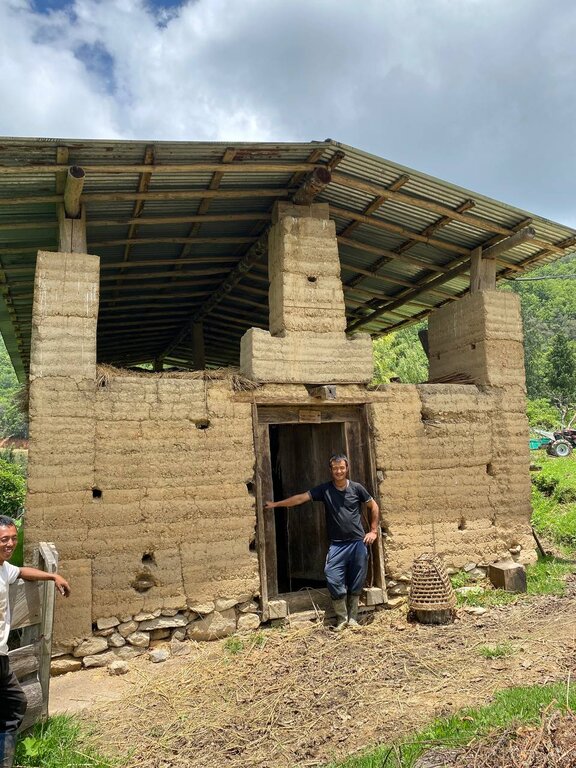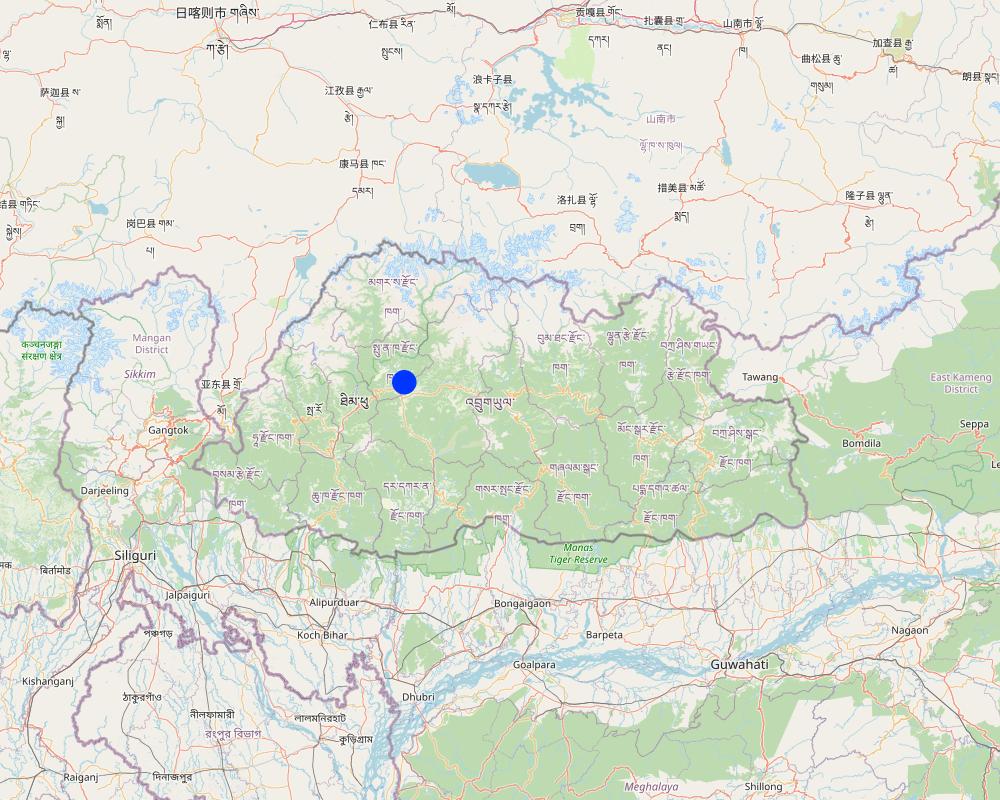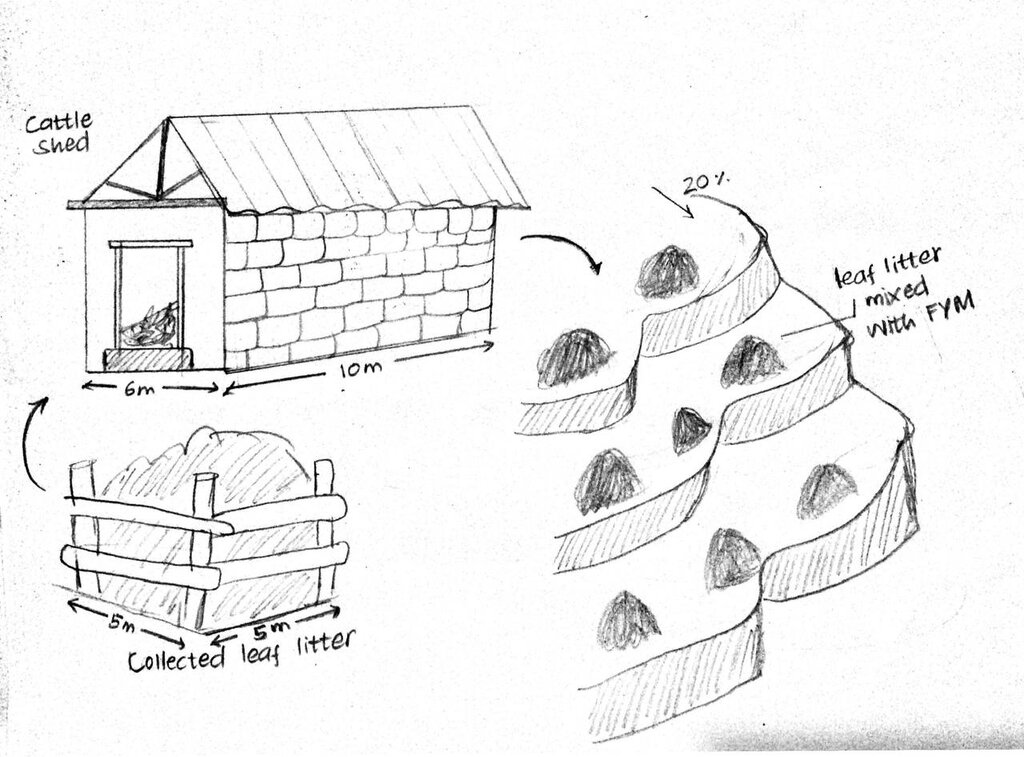Leaf Litter Collection for FYM Production [ภูฏาน]
- ผู้สร้างสรรค์:
- การอัพเดท:
- ผู้รวบรวม: Karma Wangdi
- ผู้เรียบเรียง: Tashi Wangdi
- ผู้ตรวจสอบ: William Critchley, Rima Mekdaschi Studer
Sochhag Tey Nor Lue Zhoni (གསོ་འཕྱག་སྟེ་ནོར་ལུད་བཟོ་ནི།)
technologies_6818 - ภูฏาน
ดูส่วนย่อย
ขยายทั้งหมด ย่อทั้งหมด1. ข้อมูลทั่วไป
1.2 รายละเอียดที่ติดต่อได้ของผู้รวบรวมและองค์กรที่เกี่ยวข้องในการประเมินและการจัดเตรียมทำเอกสารของเทคโนโลยี
วิทยากรหลัก
ผู้ใช้ที่ดิน:
Norbu Dawa
Lingmukha Chiwog (Community), Lingmukha Gewog (Block), Punakha Dzongkhag (District)
ภูฏาน
ชื่อของโครงการซึ่งอำนวยความสะดวกในการทำเอกสารหรือการประเมินเทคโนโลยี (ถ้าเกี่ยวข้อง)
Strengthening national-level institutional and professional capacities of country Parties towards enhanced UNCCD monitoring and reporting – GEF 7 EA Umbrella II (GEF 7 UNCCD Enabling Activities_Umbrella II)ชื่อขององค์กรซึ่งอำนวยความสะดวกในการทำเอกสารหรือการประเมินเทคโนโลยี (ถ้าเกี่ยวข้อง)
National Soil Services Center, Department of Agric (National Soil Services Center, Department of Agric) - ภูฏาน1.3 เงื่อนไขการใช้ข้อมูลที่ได้บันทึกผ่านทาง WOCAT
ผู้รวบรวมและวิทยากรหลักยอมรับเงื่อนไขเกี่ยวกับการใช้ข้อมูลที่ถูกบันทึกผ่านทาง WOCAT:
ใช่
1.4 การเปิดเผยเรื่องความยั่งยืนของเทคโนโลยีที่ได้อธิบายไว้
เทคโนโลยีที่ได้อธิบายไว้นี้เป็นปัญหาของความเสื่อมโทรมโทรมของที่ดินหรือไม่ จึงไม่ได้รับการยอมรับว่าเป็นเทคโนโลยีเพื่อการจัดการที่ดินอย่างยั่งยืน:
ไม่ใช่
แสดงความคิดเห็น:
This technology is practiced for decades without any problems regarding land degradation. While leaf litter collection can have positive effects when managed sustainably, there are also potential negative impacts associated with excessive or improper leaf litter collection
2. การอธิบายลักษณะของเทคโนโลยี SLM
2.1 การอธิบายแบบสั้น ๆ ของเทคโนโลยี
คำจำกัดความของเทคโนโลยี:
Leaf litter collection is the practice of collecting leaf litter from a designated forest area called sokshing and using it as bedding material for cattle. It then forms a constituent of farmyard manure which is applied to farmland.
2.2 การอธิบายแบบละเอียดของเทคโนโลยี
คำอธิบาย:
Leaf litter collection, is the practice of collecting leaf litter from a designated forest area called sokshing and using it as bedding material for cattle. It then forms a constituent of farmyard manure which is applied to farmland. The term 'sokshing' comes from 'sok' meaning leaf litter and 'shing' meaning tree. The tradition of harvesting leaf litter from a designated forest area for agricultural use has been in practice for decades in the life of Bhutanese farmer (Chettri et al., 2012). According to BHUCAT, 2012, the use of sokshing is a widely used traditional farming practice in Bhutan with dominance in temperate regions but spreading into more humid subtropical areas. Leaf litter from the forests is used for the purpose of livestock bedding and then farmyard manure (FYM) production. Leaf litter as animal bedding is kept for a few months to almost a year. In Bhutanese society leaf litter is an important component of agriculture because of its contribution to manure production with most communities having designated specific forest management units for its production and collection for individuals or for communities. Sokshing is an important and highly relevant system and it continues to be important for villagers, even in the face of changing livelihood and institutional orientations. The government recognises sokshing and its institutions as a relevant mechanism for community forest management (Dorji et al., 2003).
Leaf litter, predominantly gathered during the winter when the leaves have fallen, is collected from the forest floor by cleaning the entire understorey. It is carried to the farm and stored before being used as bedding material for cattle, providing comfort and insulation from cold. It is then mixed with cattle manure to form farmyard manure (FYM), (BHUCAT, 2012). FYM and mineral fertilizers are the two main sources of plant nutrients in Bhutan. Farmers not only depend on forests for leaf litter but also for livestock feed and construction materials (Gautam, 2009). FYM is a mixture of animal dung, crop residues, and other organic materials and plays a vital role in enhancing soil fertility and improving crop productivity. Its application to agricultural fields provides numerous benefits. Recent research by Gupta et al. (2022) demonstrated the positive impact of FYM on soil health and crop yields. The study found that FYM application significantly increased soil organic carbon content, which is essential for soil structure, water holding capacity, and nutrient retention. Furthermore, FYM enhanced the availability of essential nutrients such as nitrogen, phosphorus, and potassium, promoting optimal plant growth and development. Additionally, FYM improved soil microbial activity, leading to enhanced nutrient cycling and improved nutrient uptake by plants.
Leaf litter collection plays a role in ecosystem health and functioning. The accumulation of fallen leaves on the forest floor contributes to nutrient cycling, soil health, and moisture retention. Despite its benefits, the sokshing process exposes the forest's soil to erosion because all the leaves, debris, and undergrowth are removed. Nutrient mining occurs over time as a result of the annual removal of leaf litter, and many sokshing forests exhibit stunted growth and other signs of forest degradation. However, on balance, when used in conjunction with dairy production, sokshing offers a low-cost, readily available supply of bedding and then organic fertilizer, although it is labour-intensive.
In some situations, there may be specific benefits in removing the litter. A recent study by Jiang et al. (2021) emphasized the importance of leaf litter collection for mitigating the negative impacts of invasive species. The research found that invasive plants can alter the decomposition rates of leaf litter, disrupting nutrient cycling and leading to changes in soil properties. By collecting leaf litter, especially in areas where invasive species are prevalent, we can minimize their detrimental effects and help preserve the ecological balance.
2.3 รูปภาพของเทคโนโลยี
2.4 วีดีโอของเทคโนโลยี
วันที่:
06/07/2023
สถานที่:
Proper Lingmukha
ชื่อผู้ถ่ายวีดีโอ:
Niki Rai
2.5 ประเทศภูมิภาค หรือสถานที่ตั้งที่เทคโนโลยีได้นำไปใช้และได้รับการครอบคลุมโดยการประเมินนี้
ประเทศ:
ภูฏาน
ภูมิภาค/รัฐ/จังหวัด:
Bhutan
ข้อมูลจำเพาะเพิ่มเติมของสถานที่ตั้ง :
Punakha, Lingmukha
ระบุการกระจายตัวของเทคโนโลยี:
- ใช้ ณ จุดที่เฉพาะเจาะจงหรือเน้นไปยังบริเวณพื้นที่ขนาดเล็ก
Is/are the technology site(s) located in a permanently protected area?
ไม่ใช่
แสดงความคิดเห็น:
The end product, FYM, is located in the farmer's own field.
Map
×2.6 วันที่การดำเนินการ
ถ้าไม่รู้ปีที่แน่นอน ให้ระบุวันที่โดยประมาณ:
- มากกว่า 50 ปี (แบบดั้งเดิม)
2.7 คำแนะนำของเทคโนโลยี
ให้ระบุว่าเทคโนโลยีถูกแนะนำเข้ามาอย่างไร:
- เป็นส่วนหนึ่งของระบบแบบดั้งเดิมที่ทำก้นอยู่ (> 50 ปี)
ความคิดเห็น (ประเภทของโครงการ เป็นต้น) :
Traditional farming practices in Bhutan
3. การจัดประเภทของเทคโนโลยี SLM
3.1 วัตถุประสงค์หลักของเทคโนโลยี
- ปรับปรุงการผลิตให้ดีขึ้น
- สร้างผลกระทบทางด้านเศรษฐกิจที่เป็นประโยชน์
- สร้างผลกระทบทางด้านสังคมที่เป็นประโยชน์
- Bedding materials for cattle
3.2 ประเภทของการใช้ที่ดินในปัจจุบันที่ได้นำเทคโนโลยีไปใช้

พื้นที่ปลูกพืช
- การปลูกพืชล้มลุกอายุปีเดียว
Annual cropping - Specify crops:
- cereals - barley
- cereals - other
- potatoes, chili and beans
Annual cropping system:
Vegetables - wheat/barley/oat/upland rice
จำนวนของฤดูเพาะปลูกต่อปี:
- 1
ระบุ:
once a year
Is intercropping practiced?
ไม่ใช่
Is crop rotation practiced?
ใช่
ถ้าใช่ ระบุ:
Cereals-Vegetables
แสดงความคิดเห็น:
Owner grows all the cereal crops (Locally known as 'Dru na gu'). The farm is the focus for the FYM application so that is described here.
3.3 Has land use changed due to the implementation of the Technology?
Has land use changed due to the implementation of the Technology?
- No (Continue with question 3.4)
Land use mixed within the same land unit:
ใช่
Specify mixed land use (crops/ grazing/ trees):
- วนเกษตร (Agroforestry)

พื้นที่ปลูกพืช
- การปลูกพืชล้มลุกอายุปีเดียว
Annual cropping - Specify crops:
- cereals - other
- vegetables - other
- Beans, Chili, potatoes
Annual cropping system:
Vegetables - wheat/barley/oat/upland rice
Is intercropping practiced?
ไม่ใช่
Is crop rotation practiced?
ใช่
ถ้าใช่ ระบุ:
cereals- Vegetables
แสดงความคิดเห็น:
Owner grows all the cereal crops (Locally known as 'Dru na gu'). The farm is the focus for the FYM application so that is described here.
3.4 การใช้น้ำ
การใช้น้ำของที่ดินที่มีการใช้เทคโนโลยีอยู่:
- น้ำฝนร่วมกับการชลประทาน
แสดงความคิดเห็น:
Irrigation is relied upon for crops like chili and cole crops when rainfed conditions are insufficient.
3.5 กลุ่ม SLM ที่ตรงกับเทคโนโลยีนี้
- การจัดการป่าธรรมชาติและกึ่งธรรมชาติ
- การจัดการปลูกพืชร่วมกับปศุสัตว์
- การจัดการความอุดมสมบรูณ์ของดินแบบผสมผสาน
3.6 มาตรการ SLM ที่ประกอบกันเป็นเทคโนโลยี

มาตรการจัดการพืช
- A2: อินทรียวัตถุในดิน/ความอุดมสมบูรณ์ในดิน
- A6: Residue management
- A7: Others
A6: Specify residue management:
A 6.3: collected

มาตรการอนุรักษ์ด้วยการจัดการ
- M6: การจัดการของเสีย (การทำ รีไซเคิล การเอากลับมาใช้ใหม่หรือการลดปริมาณ)
แสดงความคิดเห็น:
They are collecting leaf litter from forest
3.7 รูปแบบหลักของการเสื่อมโทรมของที่ดินที่ได้รับการแก้ไขโดยเทคโนโลยี

การกัดกร่อนของดินโดยน้ำ
- Wt (Loss of topsoil): การสูญเสียดินชั้นบนหรือการกัดกร่อนที่ผิวดิน

การกัดกร่อนของดินโดยลม
- Et (Loss of topsoil): การสูญเสียดินชั้นบน

การเสื่อมโทรมของดินทางด้านชีวภาพ
- Bc (Reduction of vegetation cover): การลดลงของจำนวนพืชที่ปกคลุมดิน
- Bq (Quantity/biomass decline): การลดลงของปริมาณหรือมวลชีวภาพ
- Bl (Loss of soil life): การสูญเสียสิ่งมีชีวิตในดิน
แสดงความคิดเห็น:
that farmland is protected against degradation because FYM application however, Forest land are left barren after collecting the residues exposing the area to natural calamities such as erosion, destroying natural habitats of microorganisms.
3.8 การป้องกัน การลดลง หรือการฟื้นฟูความเสื่อมโทรมของที่ดิน
ระบุเป้าหมายของเทคโนโลยีกับความเสื่อมโทรมของที่ดิน:
- ไม่สามารถใช้ได้
แสดงความคิดเห็น:
While this technology may not directly address land degradation, it involves utilizing forest residues to produce farmyard manure (FYM) for crop cultivation, leading to improved fertility of the cultivated land. however there are also potential negative impacts associated with excessive or improper leaf litter collection to the forest area.
4. ข้อมูลจำเพาะด้านเทคนิค กิจกรรมการนำไปปฏิบัติใช้ ปัจจัยนำเข้า และค่าใช้จ่าย
4.1 แบบแปลนทางเทคนิคของเทคโนโลยี
ข้อมูลจำเพาะด้านเทคนิค (แบบแปลนทางเทคนิคของเทคโนโลยี):
Technical specifications as given above
ผู้เขียน:
karma Wangdi
วันที่:
06/07/2023
4.2 ข้อมูลทั่วไปเกี่ยวกับการคำนวณปัจจัยนำเข้าและค่าใช้จ่าย
ให้ระบุว่าค่าใช้จ่ายและปัจจัยนำเข้าได้รับการคำนวณอย่างไร:
- ต่อหน่วยเทคโนโลยี
โปรดระบุหน่วย:
Cattle shed area
Specify dimensions of unit (if relevant):
15/10
อื่นๆ หรือสกุลเงินประจำชาติ (ระบุ):
Ngultrum
If relevant, indicate exchange rate from USD to local currency (e.g. 1 USD = 79.9 Brazilian Real): 1 USD =:
82.0
ระบุค่าเฉลี่ยของค่าจ้างในการจ้างแรงงานต่อวัน:
800
4.3 กิจกรรมเพื่อการจัดตั้ง
| กิจกรรม | Timing (season) | |
|---|---|---|
| 1. | Site selection | Winter |
| 2. | Collection of cosnstruction materials | Before on set of rain |
| 3. | hiring of labors | Before the cultivation |
| 4. | Construction of the cow shed | winter |
| 5. | collection of leaf litters from the forest | winter |
| 6. | Stocking and use of leaf litter as bedding materials in the cow shed | winter |
| 7. | Let the leaf litter decompose for a month or more | anytime |
| 8. | Application of FYM during the field preparation | Before the cultivation of crops |
แสดงความคิดเห็น:
Establishment is done based at his own convenience and he has to bear all the establishment cost
4.4 ค่าใช้จ่ายของปัจจัยนำเข้าที่จำเป็นสำหรับการจัดตั้ง
| ปัจจัยนำเข้า | หน่วย | ปริมาณ | ค่าใช้จ่ายต่อหน่วย | ค่าใช้จ่ายทั้งหมดต่อปัจจัยนำเข้า | %ของค่าใช้จ่ายที่ก่อให้เกิดขึ้นโดยผู้ใช้ที่ดิน | |
|---|---|---|---|---|---|---|
| แรงงาน | person days | 15.0 | 800.0 | 12000.0 | 100.0 | |
| อุปกรณ์ | Spade | no. | 6.0 | 100.0 | ||
| อุปกรณ์ | crowbar | no. | 3.0 | 100.0 | ||
| อุปกรณ์ | pickaxe | no. | 2.0 | 100.0 | ||
| อุปกรณ์ | sickle | no. | 3.0 | 100.0 | ||
| อุปกรณ์ | wire | metre | 50.0 | 100.0 | ||
| อุปกรณ์ | knife | no. | 3.0 | 100.0 | ||
| อุปกรณ์ | Power chain | no. | 1.0 | 98.0 | ||
| วัสดุสำหรับก่อสร้าง | nail | kg | 1.0 | 500.0 | 500.0 | 100.0 |
| วัสดุสำหรับก่อสร้าง | Timber | nos. | 150.0 | 350.0 | 52500.0 | 100.0 |
| วัสดุสำหรับก่อสร้าง | CGI sheet | nos. | 20.0 | 780.0 | 15600.0 | 100.0 |
| อื่น ๆ | Working Lunch and Refreshment | person day | 15.0 | 410.0 | 6150.0 | 100.0 |
| ค่าใช้จ่ายทั้งหมดของการจัดตั้งเทคโนโลยี | 86750.0 | |||||
| Total costs for establishment of the Technology in USD | 1057.93 | |||||
แสดงความคิดเห็น:
All the cost for construction including labor charge and food are all covered by the owner
4.5 การบำรุงรักษาสภาพหรือกิจกรรมที่เกิดขึ้นเป็นประจำ
| กิจกรรม | ช่วงระยะเวลา/ความถี่ | |
|---|---|---|
| 1. | Timber/wood change after damage caused by rain and heat | |
| 2. | CGI sheet replacement | |
| 3. | Leaf litter collection | |
| 4. | FYM production |
แสดงความคิดเห็น:
Repairment and repayment of construction materials are done when ever there is damage caused.
4.6 ค่าใช้จ่ายของปัจจัยนำเข้าและกิจกรรมที่เกิดขึ้นเป็นประจำที่ต้องการการบำรุงรักษา (ต่อปี)
| ปัจจัยนำเข้า | หน่วย | ปริมาณ | ค่าใช้จ่ายต่อหน่วย | ค่าใช้จ่ายทั้งหมดต่อปัจจัยนำเข้า | %ของค่าใช้จ่ายที่ก่อให้เกิดขึ้นโดยผู้ใช้ที่ดิน | |
|---|---|---|---|---|---|---|
| แรงงาน | person | 10.0 | 800.0 | 8000.0 | 100.0 | |
| อุปกรณ์ | spade | nos | 5.0 | 100.0 | ||
| อุปกรณ์ | crowbar | nos | 3.0 | 100.0 | ||
| อุปกรณ์ | pickaxe | nos | 2.0 | 100.0 | ||
| อุปกรณ์ | sickle | nos | 3.0 | 100.0 | ||
| อุปกรณ์ | wire | metre | 20.0 | 100.0 | ||
| อุปกรณ์ | knife | nos | 3.0 | 100.0 | ||
| ปุ๋ยและสารฆ่า/ยับยั้งการเจริญเติบโตของสิ่งมีชีวิต (ไบโอไซด์) | Urea | packets | 2.0 | 1300.0 | 2600.0 | 100.0 |
| วัสดุสำหรับก่อสร้าง | Nail | kg | 0.5 | 250.0 | 125.0 | 100.0 |
| วัสดุสำหรับก่อสร้าง | Timber change | nos. | 30.0 | 150.0 | 4500.0 | 100.0 |
| วัสดุสำหรับก่อสร้าง | CGI sheet change | nos. | 8.0 | 780.0 | 6240.0 | 100.0 |
| อื่น ๆ | Working lunch and Refreshment | Per Person | 10.0 | 410.0 | 4100.0 | 100.0 |
| ค่าใช้จ่ายทั้งหมดของการบำรุงรักษาสภาพเทคโนโลยี | 25565.0 | |||||
| Total costs for maintenance of the Technology in USD | 311.77 | |||||
แสดงความคิดเห็น:
Maintenance cost are all borne by the owner
4.7 ปัจจัยสำคัญที่สุดที่มีผลกระทบต่อค่าใช้จ่าย
ปัจจัยสำคัญที่สุดที่มีผลกระทบต่อค่าใช้จ่ายต่างๆ:
There are no additional off-farm income-generating activities besides vegetable production, which has an impact on the overall costs.
5. สิ่งแวดล้อมทางธรรมชาติและของมนุษย์
5.1 ภูมิอากาศ
ฝนประจำปี
- < 250 ม.ม.
- 251-500 ม.ม.
- 501-750 ม.ม.
- 751-1,000 ม.ม.
- 1,001-1,500 ม.ม.
- 1,501-2,000 ม.ม.
- 2,001-3,000 ม.ม.
- 3,001-4,000 ม.ม.
- > 4,000 ม.ม.
ระบุปริมาณน้ำฝนเฉลี่ยรายปี (ถ้ารู้) :หน่วย ม.ม.
1000.00
ข้อมูลจำเพาะ/ความคิดเห็นเรื่องปริมาณน้ำฝน:
Annual rainfall ranges from 500 mm to 1500 mm
ระบุชื่อของสถานีตรวดวัดอากาศที่ใช้อ้างอิงคือ:
National center for hydrology and metrology
เขตภูมิอากาศเกษตร
- กึ่งแห้งแล้ง
This area probably falls under warm temperate zone which is one of the Bhutan's agro-climatic zone.
5.2 สภาพภูมิประเทศ
ค่าเฉลี่ยความลาดชัน:
- ราบเรียบ (0-2%)
- ลาดที่ไม่ชัน (3-5%)
- ปานกลาง (6-10%)
- เป็นลูกคลื่น (11-15%)
- เป็นเนิน (16-30%)
- ชัน (31-60%)
- ชันมาก (>60%)
ธรณีสัณฐาน:
- ที่ราบสูง/ที่ราบ
- สันเขา
- ไหล่เขา
- ไหล่เนินเขา
- ตีนเนิน
- หุบเขา
ระดับความสูง:
- 0-100 เมตร
- 101-500 เมตร
- 501-1,000 เมตร
- 1,001-1,500 เมตร
- 1,501-2,000 เมตร
- 2,001-2,500 เมตร
- 2,501-3,000 เมตร
- 3,001-4,000 เมตร
- > 4,000 เมตร
ความคิดเห็นและข้อมูลจำเพาะเพิ่มเติมเรื่องสภาพภูมิประเทศ:
Altitude:
slope angles: 3%
5.3 ดิน
ค่าเฉลี่ยความลึกของดิน:
- ตื้นมาก (0-20 ซ.ม.)
- ตื้น (21-50 ซ.ม.)
- ลึกปานกลาง (51-80 ซ.ม.)
- ลึก (81-120 ซ.ม.)
- ลึกมาก (>120 ซ.ม.)
(ถ้ามี) ให้แนบคำอธิบายเรื่องดินแบบเต็มหรือระบุข้อมูลที่มีอยู่ เช่น ชนิดของดิน ค่า pH ของดินหรือความเป็นกรดของดิน ความสามารถในการแลกเปลี่ยนประจุบวก ไนโตรเจน ความเค็ม เป็นต้น:
Soil Type: Sandy clay loam
MC (%): 6.84
OM (%): 7.98
OC (%): 4.64
pH (H20): 5.98
EC (µs/cm): 250.20
N (%):0.23
P (ppm):0.33
K (mg/100ml):140.07
5.4 ความเป็นประโยชน์และคุณภาพของน้ำ
น้ำไหลบ่าที่ผิวดิน:
ดี
คุณภาพน้ำ (ที่ยังไม่ได้บำบัด):
เป็นน้ำเพื่อการดื่มที่ดี
Water quality refers to:
surface water
ความเค็มของน้ำเป็นปัญหาหรือไม่:
ไม่ใช่
กำลังเกิดน้ำท่วมในพื้นที่หรือไม่:
ไม่ใช่
5.5 ความหลากหลายทางชีวภาพ
ความหลากหลายทางชนิดพันธุ์:
- ปานกลาง
ความหลากหลายของแหล่งที่อยู่:
- ปานกลาง
ความคิดเห็นและข้อมูลจำเพาะเพิ่มเติมของความหลากหลายทางชีวภาพ:
The region comprises a mixture of forest, shrub-land, wetlands, alpine habitats, agricultural land, and areas around human habitation
5.6 ลักษณะของผู้ใช้ที่ดินที่นำเทคโนโลยีไปปฏิบัติใช้
อยู่กับที่หรือเร่ร่อน:
- อยู่กับที่
แนวทางการตลาดของระบบการผลิต:
- mixed (subsistence/ commercial)
รายได้ที่มาจากนอกฟาร์ม:
- < 10% ของรายได้ทั้งหมด
ระดับของความมั่งคั่งโดยเปรียบเทียบ:
- พอมีพอกิน
เป็นรายบุคคล/ครัวเรือน:
- เป็นรายบุคคล/ครัวเรือน
ระดับของการใช้เครื่องจักรกล:
- งานที่ใช้แรงกาย
เพศ:
- หญิง
- ชาย
อายุของผู้ใช้ที่ดิน:
- วัยกลางคน
ระบุลักษณะอื่นๆที่เกี่ยวข้องของผู้ใช้ที่ดิน:
Owner is a native of Lingmukha
5.7 Average area of land used by land users applying the Technology
- < 0.5 เฮกตาร์
- 0.5-1 เฮกตาร์
- 1-2 เฮกตาร์
- 2-5 เฮกตาร์
- 5-15 เฮกตาร์
- 15-50 เฮกตาร์
- 50-100 เฮกตาร์
- 100-500 เฮกตาร์
- 500-1,000 เฮกตาร์
- 1,000-10,000 เฮกตาร์
- >10,000 เฮกตาร์
พิจารณาว่าเป็นขนาดเล็ก กลาง หรือขนาดใหญ่ (ซึ่งอ้างอิงถึงบริบทระดับท้องถิ่น):
- ขนาดกลาง
แสดงความคิดเห็น:
He owns 5 acres of land where by he cultivates cereals, vegetables and some fruit trees
5.8 กรรมสิทธิ์ในที่ดิน สิทธิในการใช้ที่ดินและสิทธิในการใช้น้ำ
- Family
- Family
สิทธิในการใช้น้ำ:
- เกี่ยวกับชุมชน (ถูกจัดระเบียบ)
Are land use rights based on a traditional legal system?
ใช่
ระบุ:
Water User Group and bylaws
5.9 การเข้าถึงบริการและโครงสร้างพื้นฐาน
สุขภาพ:
- จน
- ปานกลาง
- ดี
การศึกษา:
- จน
- ปานกลาง
- ดี
ความช่วยเหลือทางด้านเทคนิค:
- จน
- ปานกลาง
- ดี
การจ้างงาน (เช่น ภายนอกฟาร์ม):
- จน
- ปานกลาง
- ดี
ตลาด:
- จน
- ปานกลาง
- ดี
พลังงาน:
- จน
- ปานกลาง
- ดี
ถนนและการขนส่ง:
- จน
- ปานกลาง
- ดี
น้ำดื่มและการสุขาภิบาล:
- จน
- ปานกลาง
- ดี
บริการด้านการเงิน:
- จน
- ปานกลาง
- ดี
แสดงความคิดเห็น:
Many of the household are average earned farmers so they are accessible to good infrastructure facilities.
6. ผลกระทบและสรุปคำบอกกล่าว
6.1 ผลกระทบในพื้นที่ดำเนินการ (On-site) จากการใช้เทคโนโลยี
ผลกระทบทางด้านเศรษฐกิจและสังคม
การผลิต
การผลิตพืชผล
แสดงความคิดเห็น/ระบุ:
After the SLM technology, crop production doubled in case of chili and cole crops.
คุณภาพพืชผล
แสดงความคิดเห็น/ระบุ:
The introduction of hybrid crops has enhanced crop quality, but it is challenging to quantify this improvement in terms of specific quantities.
การผลิตสัตว์
แสดงความคิดเห็น/ระบุ:
Enhanced bedding materials and improved living conditions for livestock animals have led to increased product production.
well this is professional estimates.
รายได้และค่าใช้จ่าย
ค่าใช่จ่ายของปัจจัยการผลิตทางการเกษตร
แสดงความคิดเห็น/ระบุ:
They are continuing the traditional farming practices
รายได้จากฟาร์ม
แสดงความคิดเห็น/ระบุ:
Farm production costs are minimal as they can produce their own organic manure directly from the field
ความหลากหลายของแหล่งผลิตรายได้
แสดงความคิดเห็น/ระบุ:
The integration of livestock and agriculture production provides farmers with various sources of income, including earnings from animal products
ผลกระทบด้านสังคมวัฒนธรรมอื่น ๆ
ความมั่นคงด้านอาหาร / พึ่งตนเองได้
แสดงความคิดเห็น/ระบุ:
The impact of technology on food security or self sufficiency cannot be quantified however in their opinion there is increase in food production after the technology. Now they can commercialized their product as well as adequate for self consumption.
ผลกระทบด้านนิเวศวิทยา
ดิน
ความชื้นในดิน
แสดงความคิดเห็น/ระบุ:
Soil moisture has been improved in the applied field where they are practising from olden days
สิ่งปกคลุมดิน
แสดงความคิดเห็น/ระบุ:
The forest's land cover has reduced because of leaf litter collection.
Specify assessment of on-site impacts (measurements):
Soil fertility and crop production improvement after technology.
6.2 ผลกระทบนอกพื้นที่ดำเนินการ (Off-site) จากการใช้เทคโนโลยี
การทับถมของดินตะกอนพื้นที่ท้ายน้ำ
Specify assessment of off-site impacts (measurements):
Disturbance to microorganisms and soil vegetation of forest. There may be downstream siltation if too much forest is denuded.
6.3 การเผชิญและความตอบสนองของเทคโนโลยีต่อการเปลี่ยนแปลงสภาพภูมิอากาศที่ค่อยเป็นค่อยไป และสภาพรุนแรงของภูมิอากาศ / ภัยพิบัติ (ที่รับรู้ได้โดยผู้ใช้ที่ดิน)
การเปลี่ยนแปลงสภาพภูมิอากาศที่ค่อยเป็นค่อยไป
การเปลี่ยนแปลงสภาพภูมิอากาศที่ค่อยเป็นค่อยไป
| ฤดู | increase or decrease | เทคโนโลยีมีวิธีการรับมืออย่างไร | |
|---|---|---|---|
| อุณหภูมิประจำปี | เพิ่มขึ้น | ไม่ค่อยดี | |
| ฝนประจำปี | ลดลง | ไม่ทราบ |
สภาพรุนแรงของภูมิอากาศ (ภัยพิบัติ)
ภัยพิบัติจากสภาพภูมิอากาศ
| เทคโนโลยีมีวิธีการรับมืออย่างไร | |
|---|---|
| ภัยจากฝนแล้ง | ปานกลาง |
6.4 การวิเคราะห์ค่าใช้จ่ายและผลประโยชน์ที่ได้รับ
ผลประโยชน์ที่ได้รับเปรียบเทียบกับค่าใช้จ่ายในการบำรุงรักษาหรือต้นทุนที่เกิดขึ้นซ้ำอีก เป็นอย่างไร (จากมุมมองของผู้ใช้ที่ดิน)
ผลตอบแทนระยะสั้น:
เป็นกลางหรือสมดุล
ผลตอบแทนระยะยาว:
เป็นกลางหรือสมดุล
6.5 การปรับตัวของเทคโนโลยี
- > 50%
ถ้ามีข้อมูลให้บอกปริมาณด้วย (จำนวนของครัวเรือนหรือครอบคลุมพื้นที่):
29 households
Of all those who have adopted the Technology, how many did so spontaneously, i.e. without receiving any material incentives/ payments?
- 91-100%
แสดงความคิดเห็น:
They have been using this technology for more than 5 decades without receiving materials, incentives and payments
6.6 การปรับตัว
เทคโนโลยีได้รับการปรับเปลี่ยนเมื่อเร็วๆนี้ เพื่อให้ปรับตัวเข้ากับสภาพที่กำลังเปลี่ยนแปลงหรือไม่:
ไม่ใช่
6.7 จุดแข็ง / ข้อได้เปรียบ / โอกาสของเทคโนโลยี
| จุดแข็ง / ข้อได้เปรียบ / โอกาสในทัศนคติของผู้ใช้ที่ดิน |
|---|
| Soil fertility improvement |
| Improved crop production. |
| Minimise the cost for buying chemical fertilizers. |
| จุดแข็ง / ข้อได้เปรียบ / โอกาสในทัศนคติของผู้รวบรวมหรือวิทยากรหลัก |
|---|
| Enhance soil structure |
| Sustainable nutrient recycling |
| Cost effective option or low cost technology |
6.8 จุดอ่อน / ข้อเสียเปรียบ / ความเสี่ยงของเทคโนโลยีและวิธีการแก้ไข
| จุดอ่อน / ข้อเสียเปรียบ / ความเสี่ยงในทัศนคติของผู้ใช้ที่ดิน | มีวิธีการแก้ไขได้อย่างไร |
|---|---|
| Habitat alteration | Reforestation and one alternative can be use of kitchen waste |
| Labor intensive | Labor exchange and power tillers for transportation |
| จุดอ่อน / ข้อเสียเปรียบ / ความเสี่ยงในทัศนคติของผู้รวบรวมหรือวิทยากรหลัก | มีวิธีการแก้ไขได้อย่างไร |
|---|---|
| Depletion of forest recourses | Strong policy on leaf litter collection |
7. การอ้างอิงและการเชื่อมต่อ
7.1 วิธีการและแหล่งข้อมูล
- ไปเยี่ยมชมภาคสนาม การสำรวจพื้นที่ภาคสนาม
1
- การสัมภาษณ์กับผู้ใช้ที่ดิน
1
- การเก็บรวบรวมมาจากรายงานและเอกสารที่มีอยู่
1
วันที่เก็บรวบรวมข้อมูล(ภาคสนาม) :
06/07/2023
แสดงความคิดเห็น:
Data were collected based on field visits and face to face interactions with the land user.
7.2 การอ้างอิงถึงสิ่งตีพิมพ์
หัวข้อ, ผู้เขียน, ปี, หมายเลข ISBN:
NSSC Bhutan catalogue of soil and water conservation approaches and technologies, 2012
ชื่อเรื่อง ผู้เขียน ปี ISBN:
Website
7.3 Links to relevant online information
ชื่อเรื่องหรือคำอธิบาย:
Traditional practice of leaf litter harvesting and utilization by farmers in west-central Bhutan: Paving the way for sustainable management
URL:
https://ag2.kku.ac.th/kaj/PDF.cfm?filename=07-Rekha.pdf&id=825&keeptrack=8
7.4 General comments
This technology doesn't fit easily into the form because it has three components (litter collection/ FYM production from bedding/ application to the field
ลิงก์และโมดูล
ขยายทั้งหมด ย่อทั้งหมดลิงก์
ไม่มีลิงก์
โมดูล
ไม่มีโมดูล


